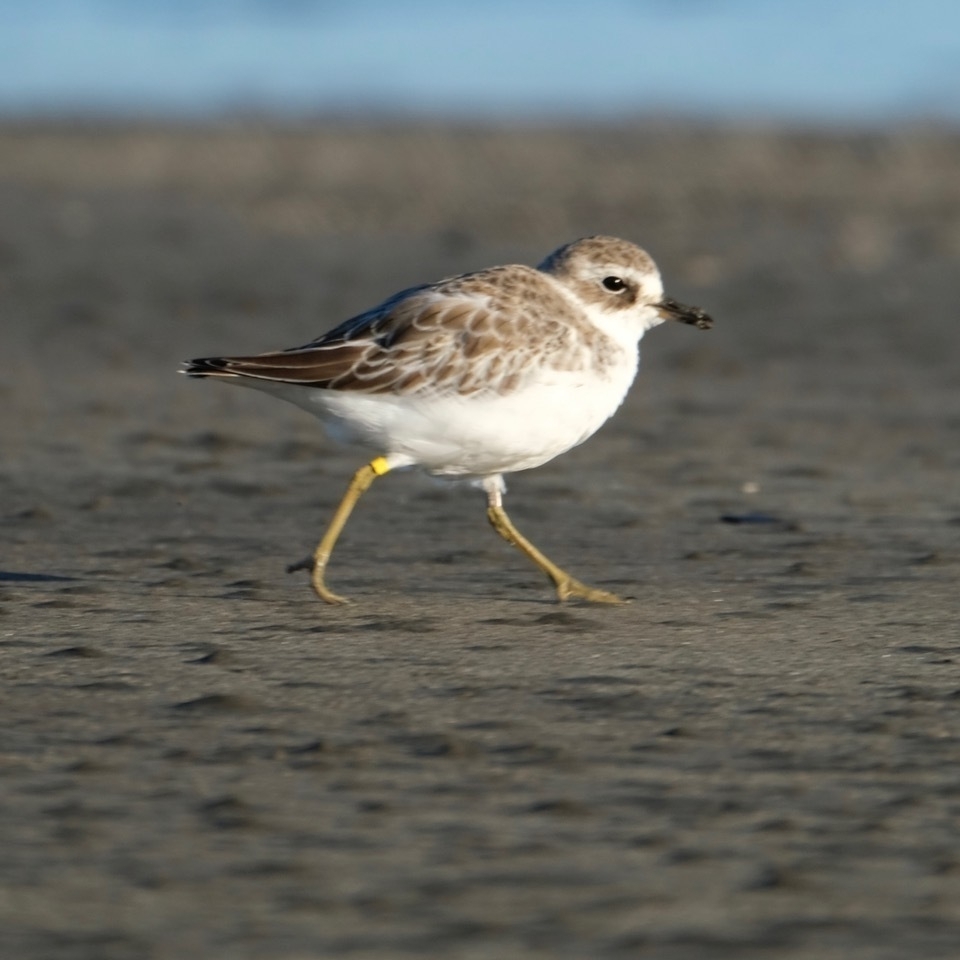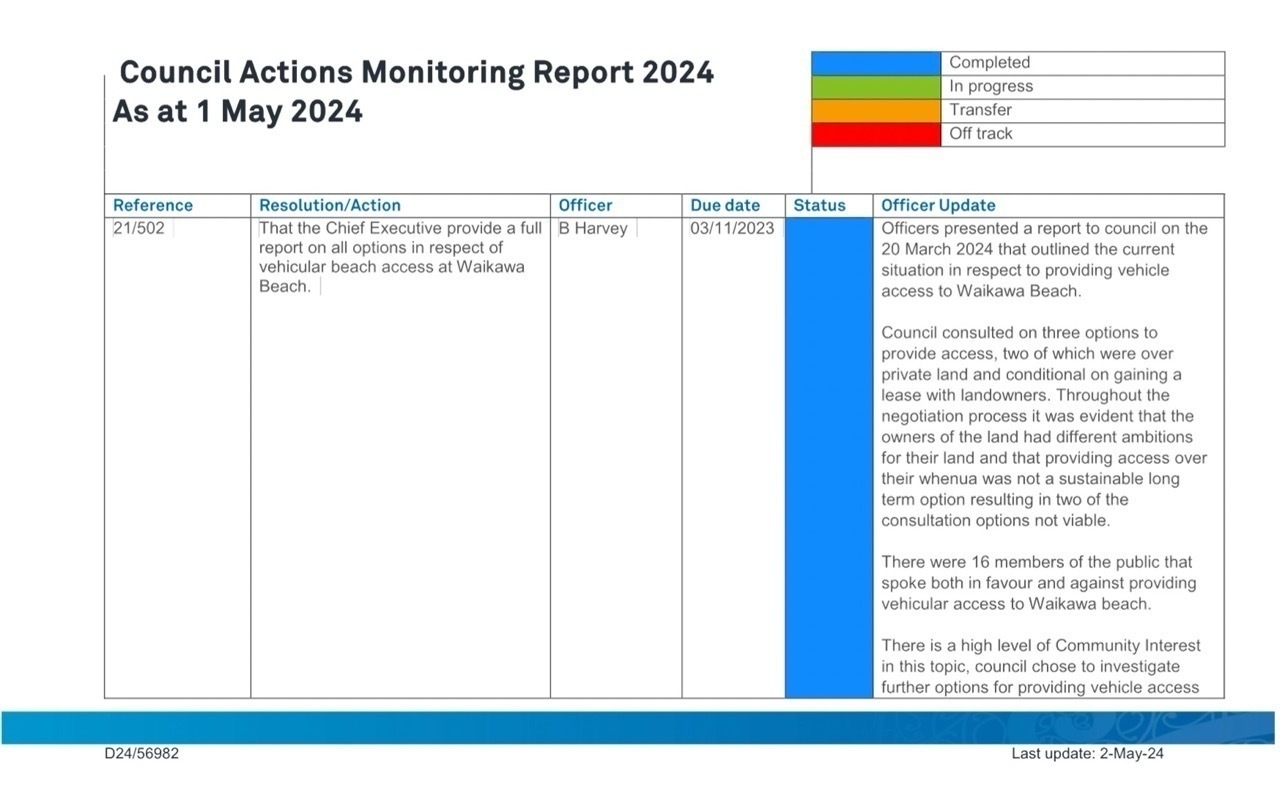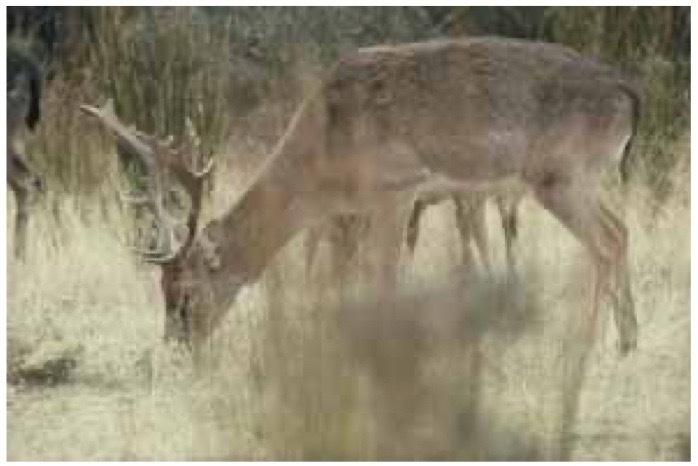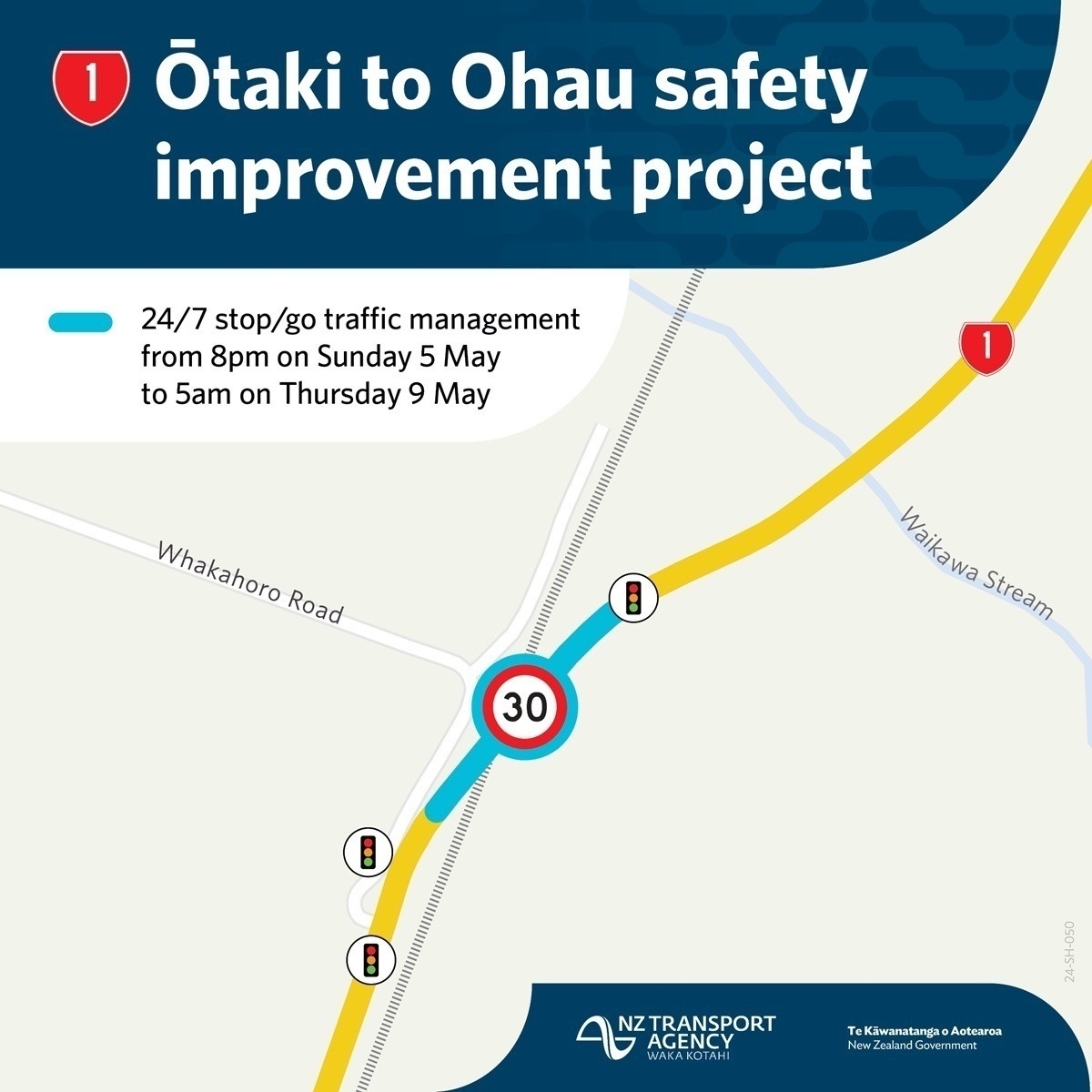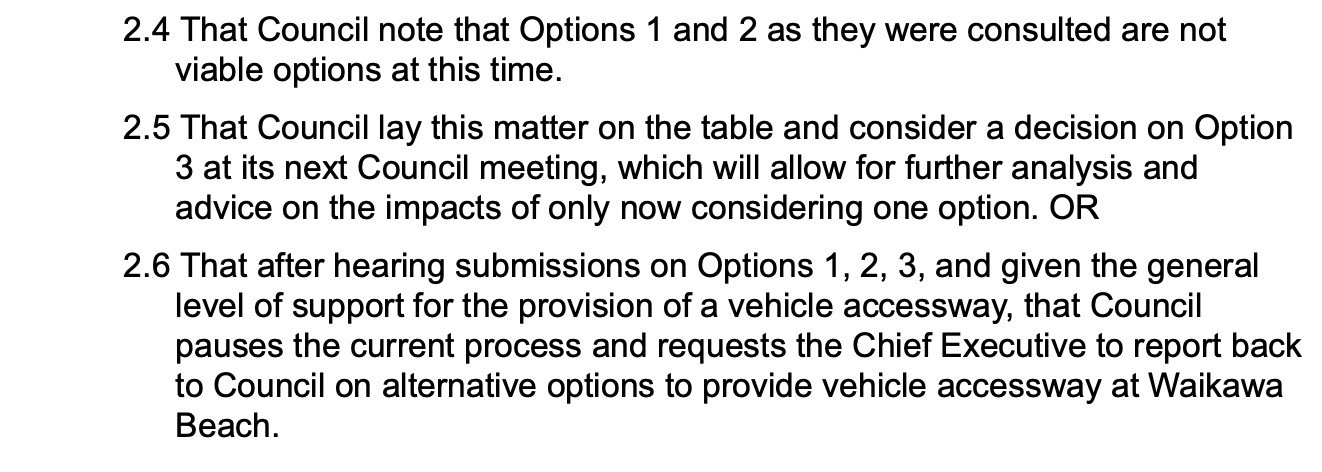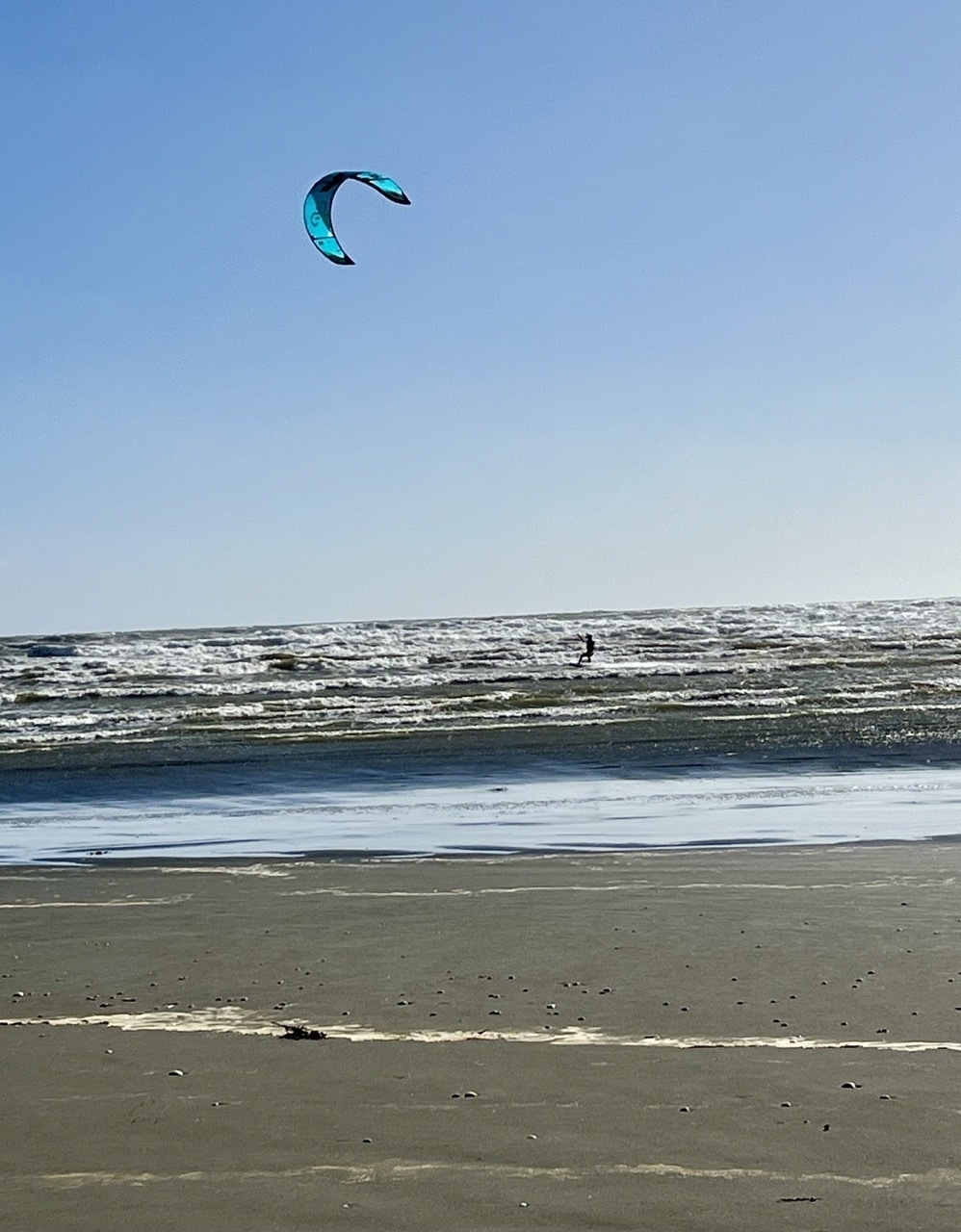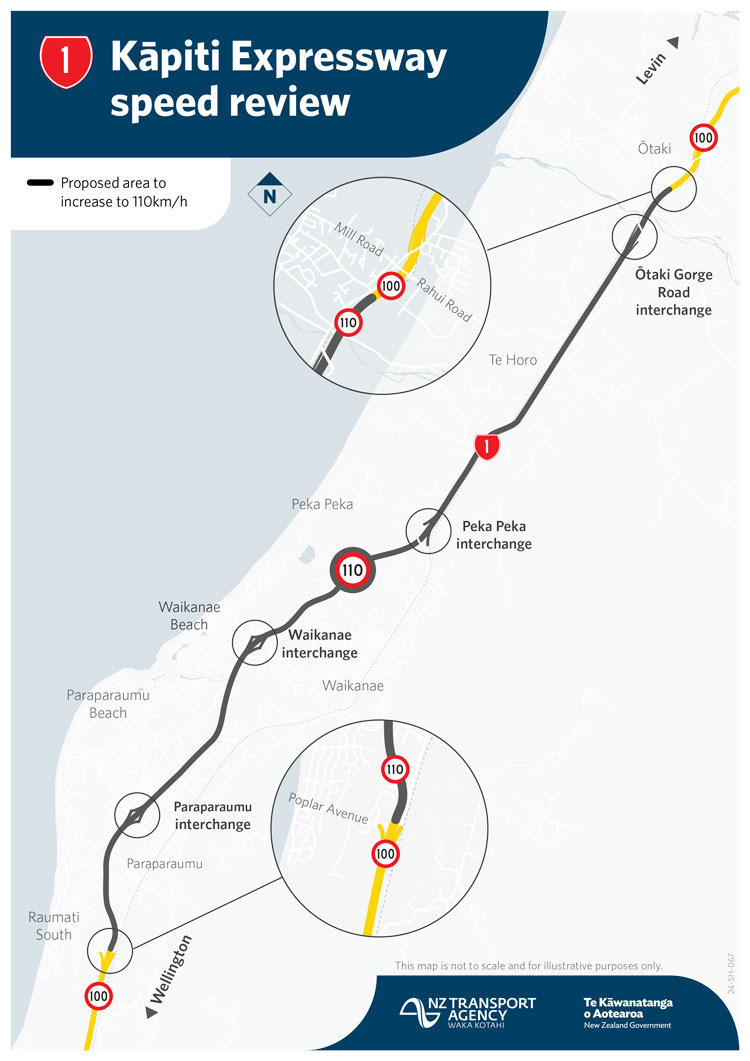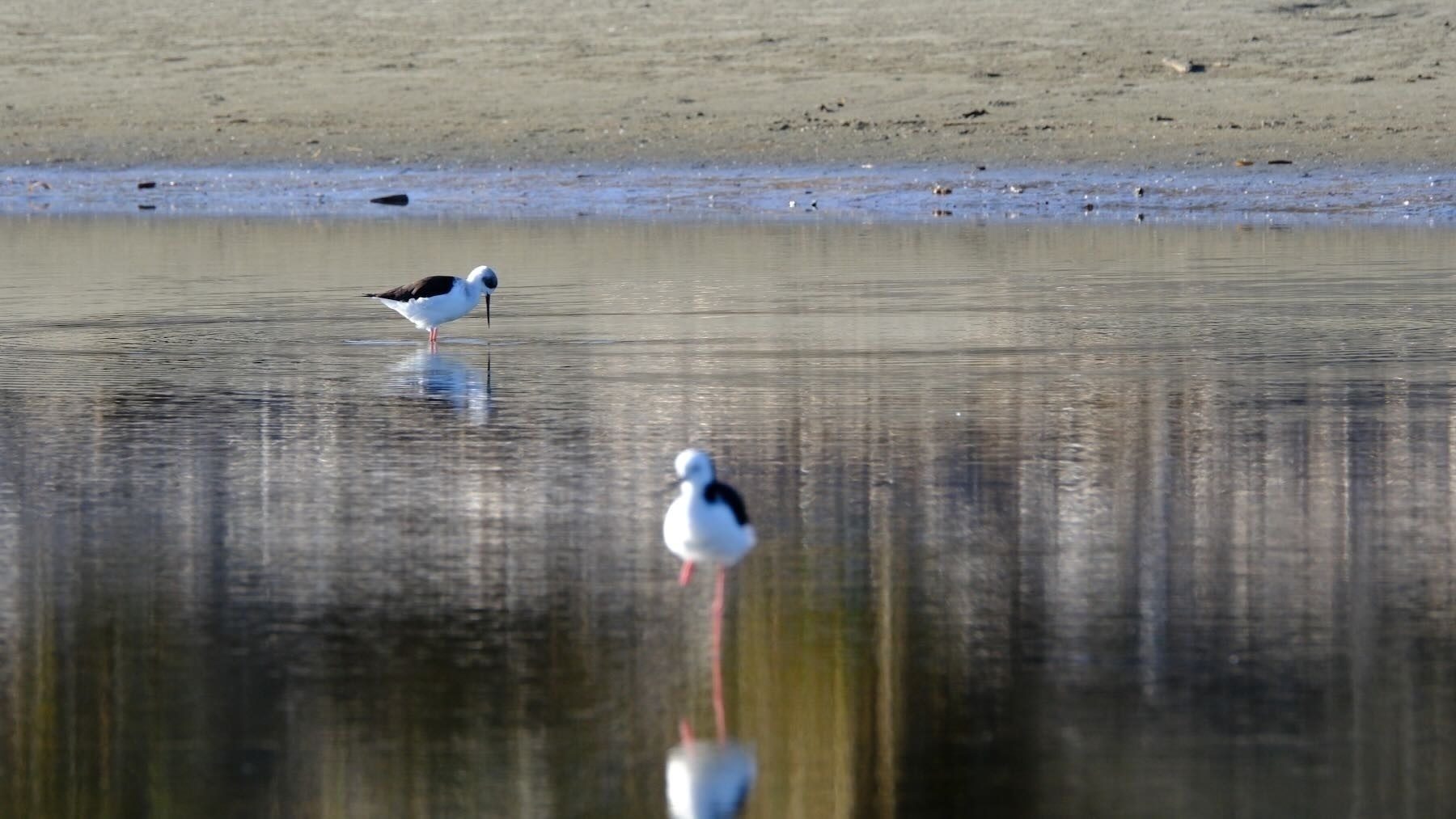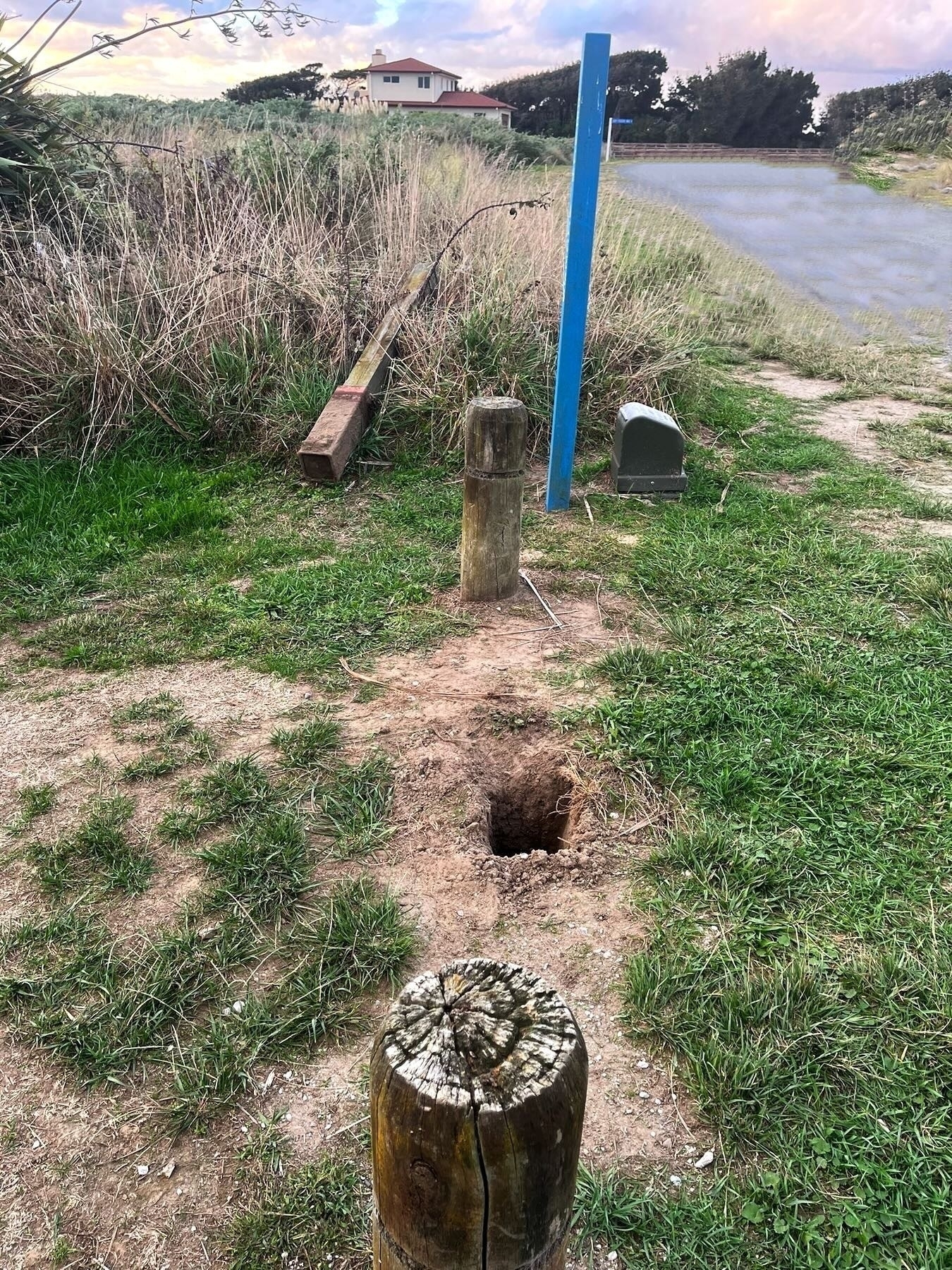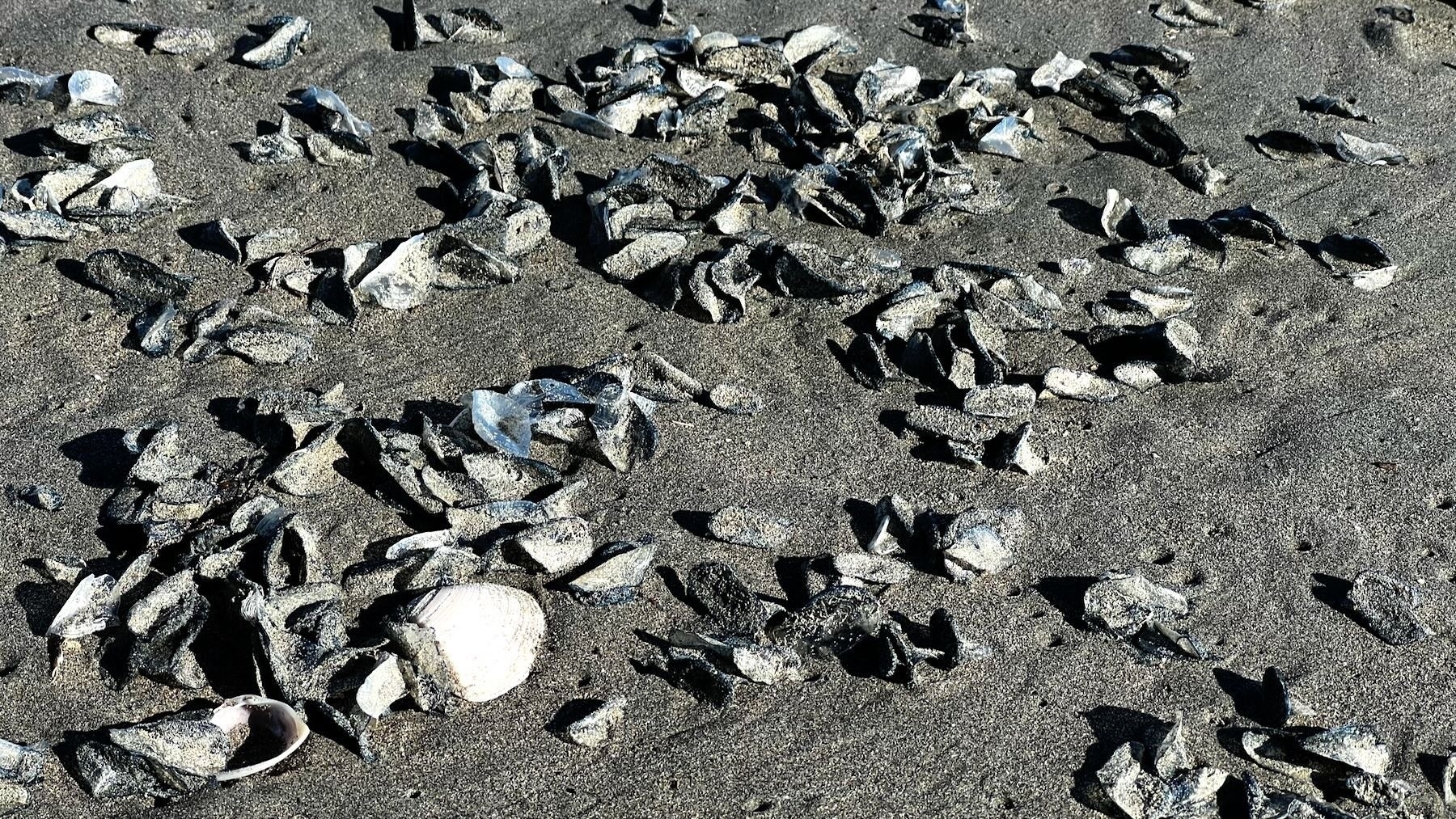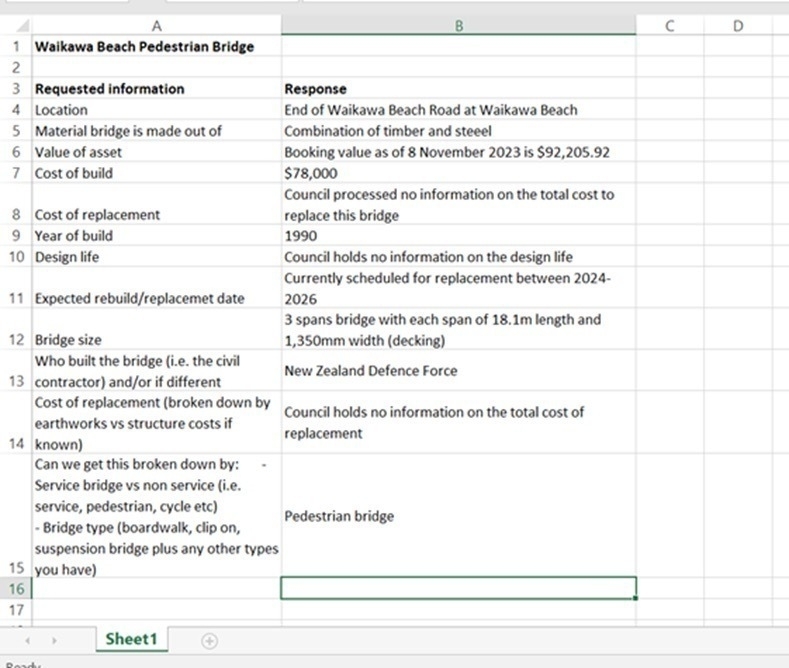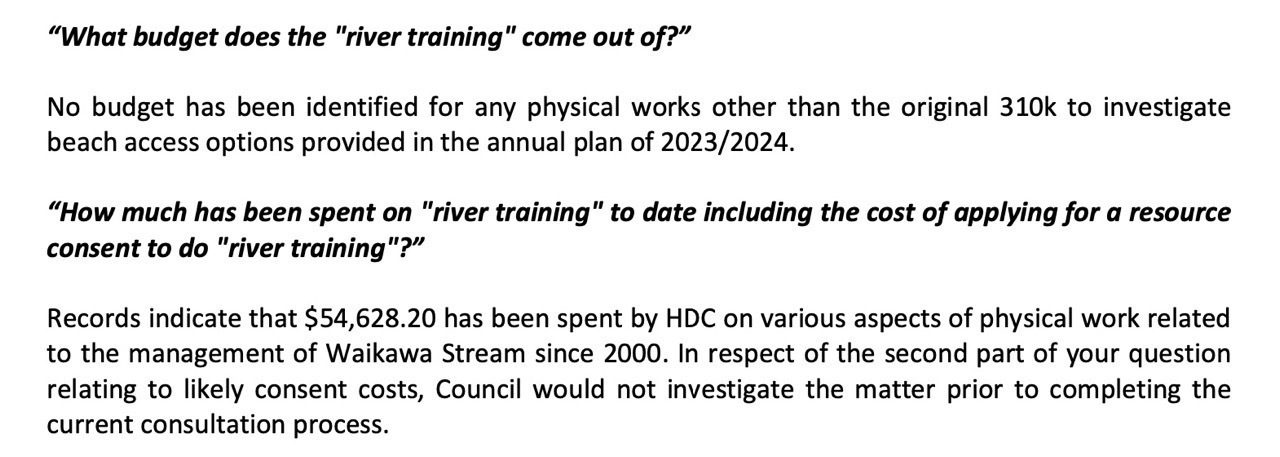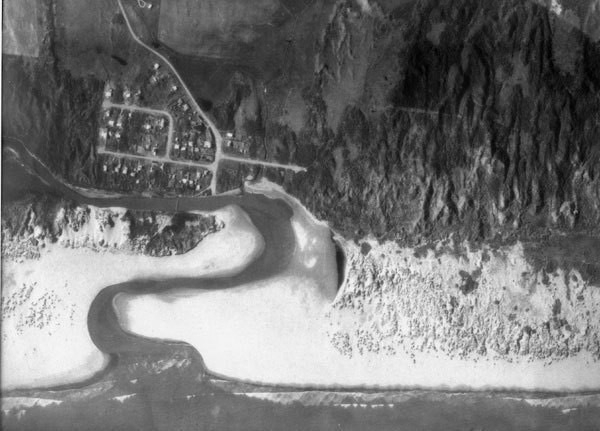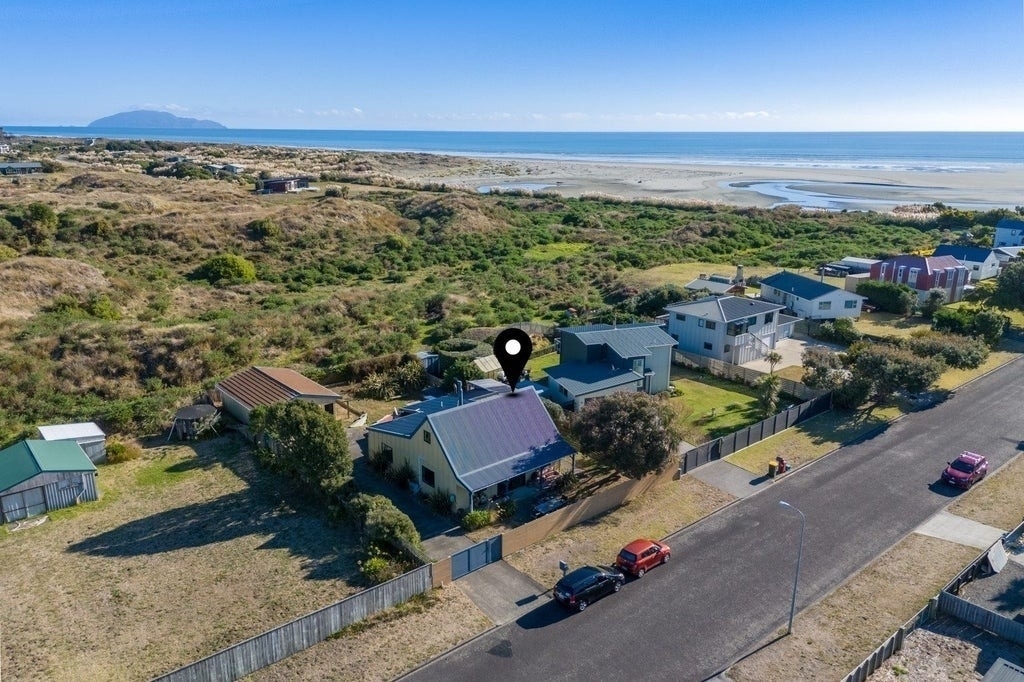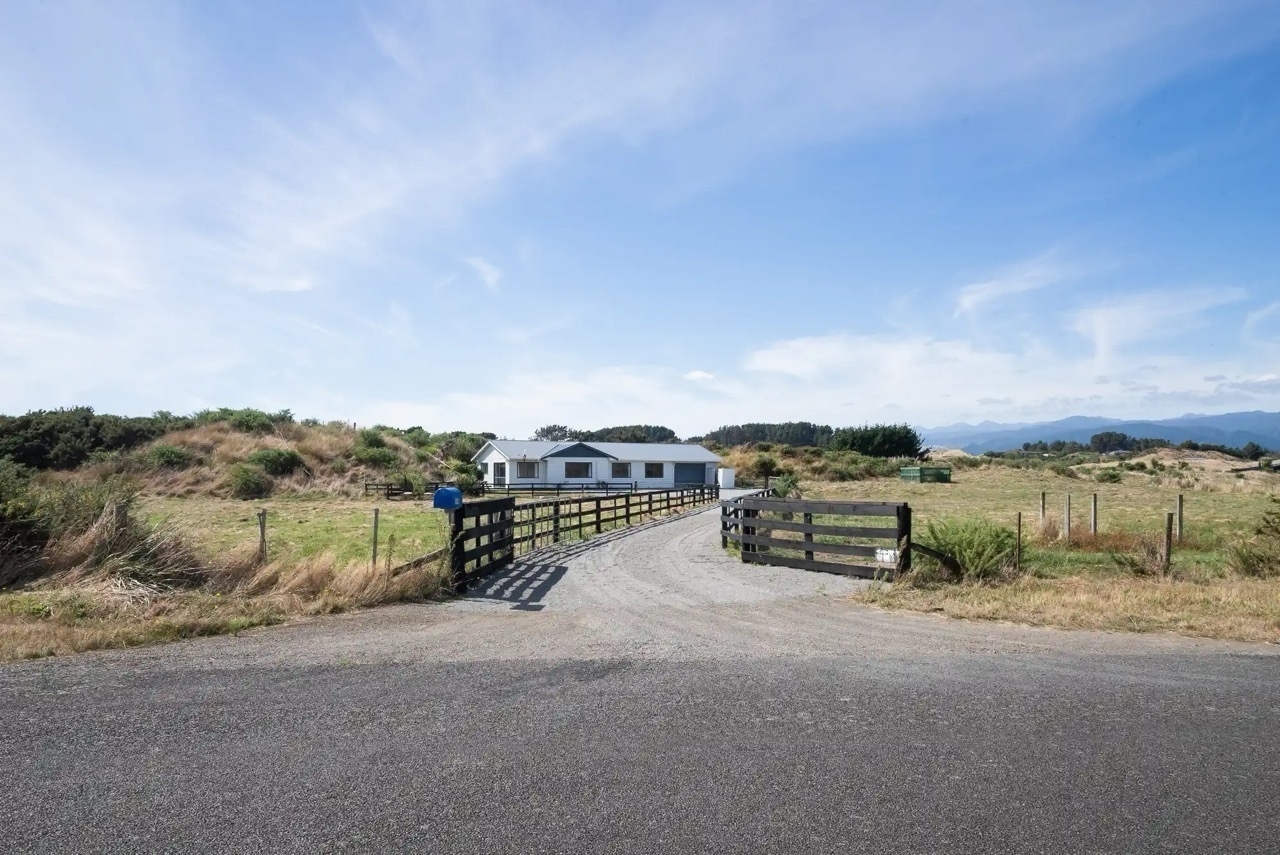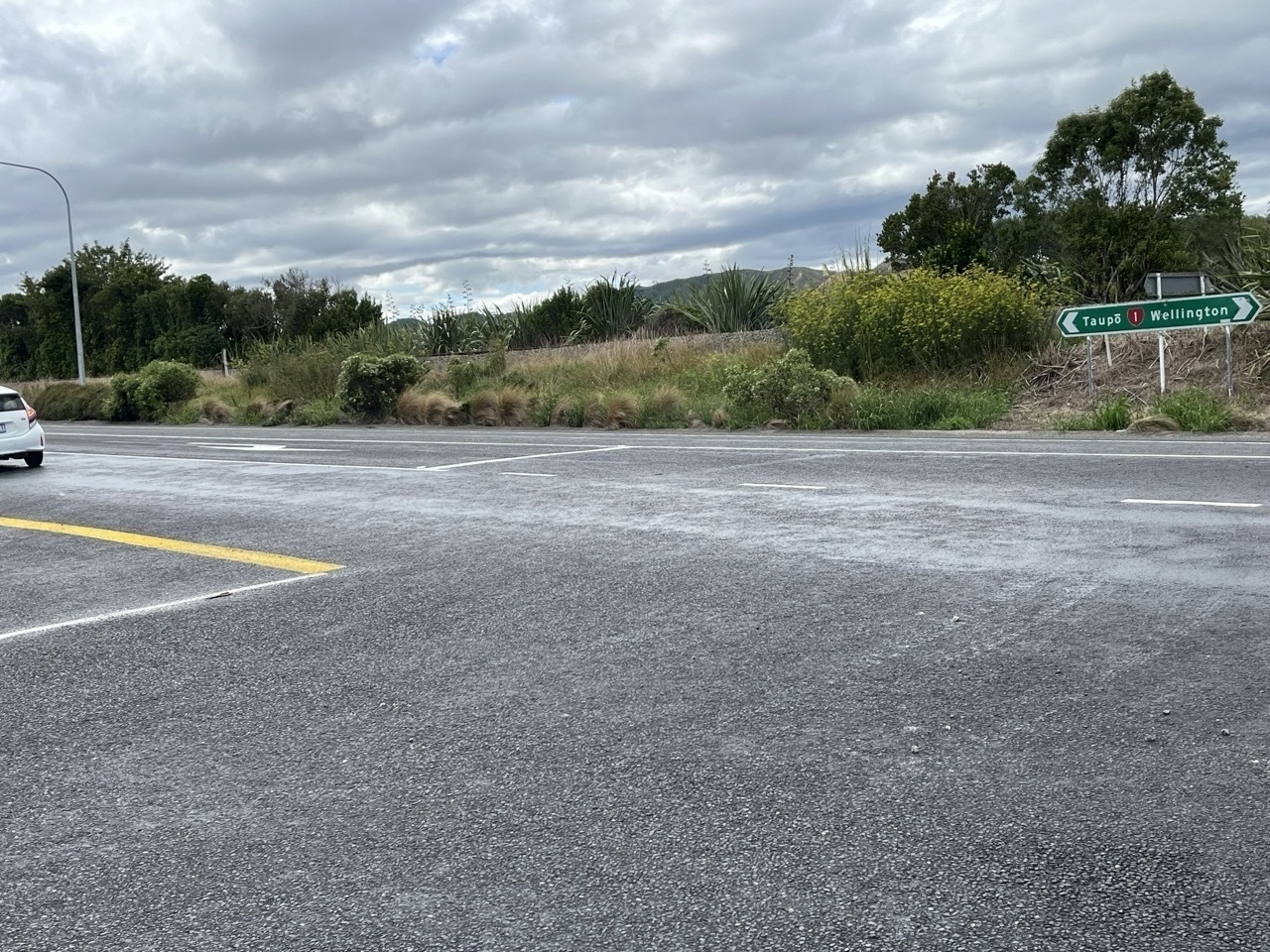Notices
Waikawa News has ceased updates. The archive of posts is still available.
Pedestrian access onto Waikawa Beach as at May 2024
Recently updated the Big List of Birds, now with 63 birds. Have you managed to see them all?
Recycling: collected every 2 weeks.
-
Photo of 'Chip' from 15 April 2023 at Waikawa Beach in Horowhenua. Yellow band on right leg, silver band on left. Sometimes, if you get a good enough look at a bird at Waikawa Beach, you might spot that it's wearing leg bands. This indicates that some researcher somewhere is interested in that bird. Back in December 2023 I reported the above photo to the Banding Office and received this reply: Thank you for reporting the finding of a banded bird, and for providing some stunning photos, which shows the metal band and coloured band so well. -
HDC Vehicle Access item 21/502 now completed
Horowhenua District Council has a regular meeting scheduled for 08 May 2024. The usual Council Actions Monitoring Report appears on the Agenda. The Waikawa Beach vehicle access option is now marked as completed: Council Actions Monitoring Report 2024 As at 01 May 2024 Ref: 21/502 Resolution / Action: That the Chief Executive provide a full report on all options in respect of vehicular beach access at Waikawa Beach. Officer: B Harvey Due Date: 30/11/2023 Status: Completed Officer Update: Officers presented a report to council on the 20 March 2024 that outlined the current situation in respect to providing vehicle access to Waikawa Beach. -
Beware wild deer on the road and beach in autumn
Fallow deer. Source: DoC A Hokio Beach motorcyclist was lucky that after hitting a deer at midnight he sustained few injuries, though his new bike was a write-off. The wild deer that jumped out in front of him wasn’t as lucky. The article below mentions that wild deer can be found on roads and even beaches (my emphasis): Wild fallow deer were more likely to be seen on New Zealand roads in autumn months like April and May. -
Manakau Rail Overbridge works cancelled - May 2024
Now Cancelled: roadworks at Manakau Rail Overbridge. I received a project email today that road works planned for 05 to 09 May 2024 at Manakau Rail Overbridge have been cancelled: We were previously in touch to advise of upcoming works at the Manakau Rail Overbridge for the Ōtaki to Ohau safety improvement project. The works required stop/go traffic management continuously over 4 days. Following further analysis of the traffic management plan, a decision has been made to cancel the works planned at the Manakau Rail Overbridge next week. -
Waikawa Beach vehicle access - minutes of the 20 March 2024 HDC meeting
New recommendations for Councillors. The (unconfirmed) Minutes of the Horowhenua District Council meeting from 20 March 2024 are now available. At that meeting there was an important discussion scheduled about the future of vehicle access at Waikawa Beach. See HDC report on beach access options for vehicles for 20 March 2024 meeting. The discussion at the meeting itself was very confusing — at one point proceedings stopped while officers clarified some points among themselves. -
Update: Sold: 125 Strathnaver Drive
Sold: 125 Strathnaver Drive. First listed 27 February 2024. Update, 26 May 2024, this was wrongly published referring to 118 Strathnaver Drive. -
Waikawa Newsletter April 2024 published
Family fun on the beach. Published on 29 April 2024: Waikawa Newsletter April 2024. The monthly newsletter is based on posts I’ve written during the month, with added sprinkles. If you’d like to automatically receive posts by email as they are published subscribe. If you know of Waikawa Beach things that would interest others or if you have comments on this newsletter or the websites please let me know at kiaora@waikawanews. -
A great day for kitesurfing
With winds gusting well over 40 Kph it’s been blustery day down at the beach today. Which has suited at least one kitesurfer very well. Many thanks to Sophie Campbell for the photos. -
Caution: burglars are about
There’s a post on the Waikawa Beach Community Facebook page from Thursday 25 April 2024 talking about break-ins at two Waikawa Beach properties. A place on Duncan Street had fishing gear stolen, while another owner on Manga Pirau Street reported a bike stolen. In one case the residents were out, but in the other they were at home at the time. These were both break-ins rather than casual opportunistic thefts but this is a reminder to secure your belongings and watch out for suspicious behaviour at your own property and also neighbouring properties. -
Increase Kāpiti Expressway speed limit to 110 Kph?
Waka Kotahi want to know our views on increasing the speed limit on the SH1 Kāpiti Expressway. Consultation closes Monday 20 May 2024. The proposal covers approximately 25 Km of road. Travelling at 100 Kph that takes 15 minutes. At 110 Kph it takes about 13.5 minutes. We’re proposing a new speed limit on the Kāpiti Expressway, from north of the Poplar Avenue at Raumati interchange to south of the Ōtaki northern interchange. -
Great days for birds at the estuary
Two pied stilts. Spotted today feeding and resting at the Estuary: 1 white-faced heron; 4 banded dotterels; 1 NZ Dotterel; a dozen pied stilts; a dozen variable oystercatchers; numerous gulls and swallows; half a dozen godwits; 80-100 white-fronted terns; 2 caspian terns; 50 or so South Island Pied Oystercatchers; several pied shags. 3 Banded Dotterels. -
Safety issues on track to the beach
The pedestrian-only track to the beach at 60 Reay Mackay Grove has been subjected to more vandalism recently. Along with clear tire tracks going along the path, a sign has been damaged and a substantial post at the road end of the track has been pulled out, leaving a hole large enough to injure anyone stepping in it (photo contributed by a reader). Watch your footing around there and keep an eye out for kids and animals who may not notice the hole. -
Traffic delays 05 to 09 May 2024 at Manakau Rail Overbridge
Stop/go traffic management in place at Manakau Rail Overbridge from Sunday 5 May 2024. The Ōtaki to north of Levin update – April 2024 from Waka Kotahi advises us about delays between Waikawa Beach Road and Ōhau from 8pm on Sunday 05 May to 5am on Thursday 09 May 2024: Plan ahead for stop/go traffic management at the Manakau Rail Overbridge from Sunday 5 May The Ōtaki to Ohau safety improvement project is now nearing completion, with all three turnaround facilities open and all side and median barriers installed. -
Stinky Velella velella are rather interesting
From time to time Velella velella wash ashore and decay. We had another event a few days ago so the beach is a bit smelly in parts. Velella velella, also known as By the Wind Sailors, are a relative of bluebottles, and a jelly fish. They use a small sail to drift on the ocean surface. These little creatures are rather interesting. Scripps Institution of Oceanography tells us: A clear, chitinous semicircular to triangular sail sticks up above the water with a blue float beneath made of concentric circles of gas-filled chambers. -
Waikawa Footbridge updates
Another Horowhenua District Council LGOIMA Response. LGOIMA stands for Local Government Official Information and Meetings Act. In November 2023, in Reference Number: 2023/1017 someone asked about the footbridge at Waikawa Beach, with regard to schedules for replacement within the next three years. The document published online had some lines cut off, but I asked for the full version and received this information: Waikawa Beach Pedestrian Bridge Requested information : Response Location : End of Waikawa Beach Road at Waikawa Beach Material bridge is made out of : Combination of timber and steeel Value of asset : Booking value as of 8 November 2023 is $92,205. -
Recent posts not emailed out
Because of a server error the following posts weren't emailed out: River training costs 2000-2024 were over $54,000, published on: Thursday, 18 April 2024. Vehicles on Horowhenua beaches - complaints, published on: Thursday, 18 April 2024. -
Game bird hunting season opens Saturday 04 May 2024
Game bird hunting season opens Saturday 04 May 2024. Shooting always starts around dawn, so if you have nervous animals be alert early on 04 May 2024 for the sounds of gunfire. Information from Fish & Game NZ — Game Bird Season. -
Vehicles on Horowhenua beaches - complaints
Another Horowhenua District Council LGOIMA Response. LGOIMA stands for Local Government Official Information and Meetings Act. In September 2023, in Reference Number: 2023/1006 someone asked about HDC's policies about vehicles on beaches. These were interesting questions (HDC has no policies), but the final response had valuable information: Regardless of whether you have any rules, regulations or bylaws restricting or prohibiting the use of vehicles on beaches in your territory, please provide the number of public concerns or complaints that have been received/reported to you concerning the use of vehicles on beaches in your territory for the past five years (broken down by year please). -
River training costs 2000-2024 were over $54,000
It can be instructive to check the Horowhenua District Council LGOIMA Responses page from time to time. LGOIMA stands for Local Government Official Information and Meetings Act. Back in November 2023 a requester asked numerous questions about vehicle access to Waikawa Beach, including several about resource consents. Some responses (PDF, Reference Number: 2023/1018) didn’t really bring any new information, but one question and answer were interesting: “How much has been spent on “river training” to date including the cost of applying for a resource consent to do “river training”? -
The good old days: Waikawa the way it used to be
Aerial view of Waikawa in 1962, showing Drake, Arthur and the northern part of Manga Pirau Streets. The article below was originally published in April 2020, but is a good reminder still, 4 years later. This Covid–19 version of Waikawa Beach, with roads empty of cars, vans and trucks, is how some longtime locals remember the good old days: “Waikawa the way it used to be”, as one said on Facebook. -
Get your Long-term Plan submissions in - recycling, E. Coli in the river, pests
HDC Long-term Plan consultation closes at 5pm on Monday 15 April 2024. See HDC Long-term Plan consultation closes 15 April 2024 for details. See below for the Horizons Regional Council Long-term Plan consultation which closes at 5pm on 22 April 2024. See also In March 2024 we need to ask for cleaner river water. Horowhenua District Councillors are trying to make very hard decisions to keep our rates increase down to around 17%. -
For sale: 6 James Street
For sale: 6 James Street. Bedrooms: 3; Bathrooms: 2; Living Area: 1; Floor Area: 146 m²; Land Area: 812 m²; also 1 Ensuite; 2 Separate toilets; 2 Garage parking. Price: by negotiation; CV: $780,000. Listed on 10 April 2024. -
Waikawa Beach access options for vehicles - decision postponed, March 2024
The Horowhenua District Council consultation period on beach access for vehicles ended on 20 February 2024, with 446 submissions. Submissions show that there is both strong support and strong opposition for vehicle access at Waikawa Beach. Councillors met on 20 March 2024 to decide how to proceed. In brief: the decision has been delayed. The Consultation Report offered 3 choices for Councillors to consider: no vehicle access at all, or two ways to pause proceedings. -
For sale: 118 Strathnaver Drive
For sale: 118 Strathnaver Drive. Auction 24 April 2024. Bedrooms: 2; Bathrooms: 1; Floor Area: 141 m²; Land Area: 9893 m². Listed 02 April 2024. -
More intersection road works, April 2024
Freshly painted (in March) southbound right turn lane. Back in January 2024 work at the intersection of SH1 and Waikawa Beach Road was finally completed, road resurfaced and (eventually, much later, in March) markings done. So it was a surprise on 02 April 2024 when workers scraped off the surface of the intersection agin. Over the next couple of nights they resealed it, and the road markings were either retained or replaced.
